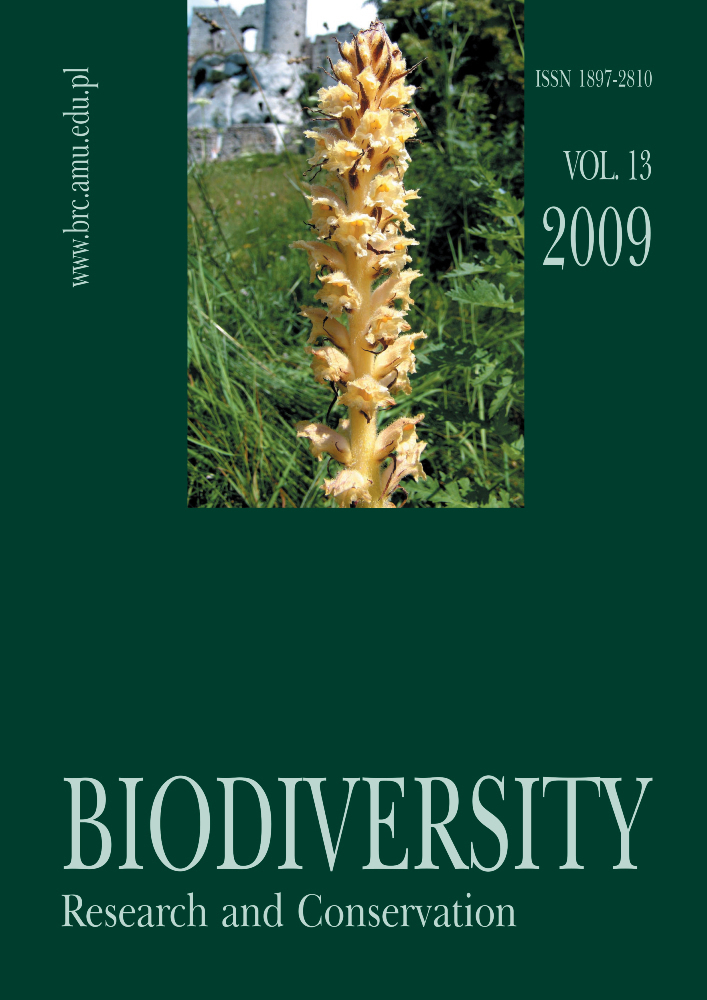Abstract
In the Křivoklátsko Protected Landscape Area (Czech Republic), the relation between genetic diversity and intensity of management was studied in 3 populations of Quercus petraea (Mattuschka) Liebl. (sessile oak). Microsatellite analysis was used to assess genetic diversity. The results indicate that differences between populations in average number of alleles per locus are so small that no genetic difference can be proved between them. The values of heterozygosity for all 3 studied populations confirm the absence of significant genetic differences among them.
References
Bakker E. G. 2001. Towards molecular tools for management of oak forests. Genetic studies on indigenous Quercus robur L. and Q. petraea (Matt.) Liebl. populations. 117 pp. Alterra Green World Research, Wageningen.
Bradshaw R. H. W. 2004. Past anthropogenic influence on European forests and some possible genetic consequences. For. Ecol. Manage. 197: 203-212.
Bruschi P., Vendramin G. G., Bussotti F. & Grossoni P. 2003. Morphological and molecular diversity among italian populations of Quercus petraea (Fagaceae). Ann. Bot. 91: 707-716.
Cottrell J. E., Munro R. C., Tabbener H. E., Milner A. D., Forrest G. I. & Lowe A. J. 2003. Comparison of fine-scale genetic structure using nuclear microsatellites within two British oakwoods differing in population history. For. Ecol. Manage. 176: 287-303.
Dow B. D., Ashley M. V. & Howe H. F. 1995. Characterization of highly variable (GA/CT)n microsatellites in the bur oak, Quercus macrocarpa.Theor. Appl. Genet. 91: 137-141.
Finkeldey R. 2000. Genetic Variation of Oaks (Quercus spp.) in Switzerland. 2. Genetic Structures in "Pure" and "Mixed" Forests of Pedunculate Oak (Q. robur L.) and Sessile Oak (Q. petraea (Matt.) Liebl.). Silvae Genet. 50: 22-30.
Jensen J. S. 1993. Variation of growth in Danish provenance trials with oak (Quercus robur L. and Quercus petraea (Mattuschka) Liebl.). Ann. Sci. For. 50 (Suppl. 1): 203-207.
Kampfer S., Lexer C., Glössl J. & Steinkellner H. 1998. Characterization of (GA)n microsatellite loci from Quercus robur.Hereditas 129: 183-186.
Lexer C., Heinze B., Gerber S., Steinkellner H., Ziegenhagen B., Kremer A. & Glössl H. 1999. Microsatellite analysis of anonymous seedlot samples from oak: a promising approach to monitor the number of different seed parents and pollen donors. In: E. M. Gillet (ed.). Which DNA marker for which purpose? Final compendium of the research project development, optimisation and validation of molecular tools for assessment of biodiversity in forest trees in the European Union DGXII Biotechnology FW IV Research Programme Molecular Tools for Biodiversity. http://webdoc.sub.gwdg.de/ebook/y/1999/whichmarker/index.htm
Muir G., Lowe A. J., Fleming C. C. & Vogl J. 2004. High nuclear genetic diversity, high levels of outcrossing and low differentiation among remnant populations of Quercus petraea at the margin of its range in Ireland. Ann. Bot. 93: 691-697.
Nei M. 1978. Estimation of average heterozygosity and genetic distance from a small numberof individuals. Genetics 101: 139-155.
Petit R. J., Kremer A. & Wagner D. B. 1993. Geographic structure of chloroplast DNA polymorphism in European oaks. Theor. Appl. Genet. 87: 122-128.
Siegismund H. R. & Jensen J. S. 2001. Intrapopulation and interpopulation genetic variation of Quercus in Denmark. Scand. J. For. Res. 16: 103-116.
Steinkellner H., Fluch S., Turetschek E., Lexer C., Streiff R., Kremer A., Burg K. & Glössl J. 1997. Identification and characterization of (GA/CT)n - microsatellite loci from Quercus petraea.Pl. Molecul. Biol. 33: 1093-1096.
Streiff R. 1999: Pollen dispersal inferred from paternity analysis in a mixed oak stand of Quercus robur L. and Q. petraea (Matt.) Liebl. Molecul. Ecol. 8: 831-841.
Streiff R. Labbe T., Bacilieri R., Steinkellner H., Gloessl J. & Kremer A. 1998. Within-population genetic structure in Quercus robur L. and Quercus petraea (Matt.) Liebl. Assessed with isozymes and microsatellites. Molecul. Ecol. 7: 317-328.
Streiff R., Ducousso A., Lexer C., Steinkellner H., Gloessl J. & Kremer A. 1999. Pollen dispersal inferred from paternity analysis in a mixed oak stand of Quercus robur L. and Q. petraea (Matt.) Liebl. Molecul. Ecol. 8: 831-841.
Ter Braak C. J. F. Šmilauer P. 1998. CANOCO reference manual and user's guide to canoco for windows. software for canonical community ordination (Version 4). 350 pp. Centre of Biometry, Wageningen.
Wang X.-R. & Szmidt A. E. 2001. Molecular markers in population genetics of forest trees. Scand. J. For. Res. 16: 199-220.
Woessner R. A. 1975. Interprovenance crosses of loblolly pine. In: D. J. Fowler & C. W. Yeatman (eds.). Proc. 14th Meeting of the Canadian Tree Improvement Association, p. 17-23. Fredricton, New Brunswick.
Yeh F. C., Yang R. C. & Boyle T. 1999. POPGENE version 1.31. A quick user guide. Univ. Alberta, Alberta.
Zanetto A. & Kremer A. 1995. Geographical structure of gene diversity in Quercus petraea (Matt.) Liebl. I. Monolocus patterns of variation. Heredity 75: 506-517.




